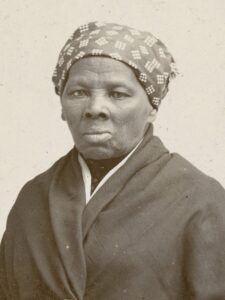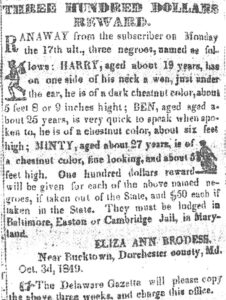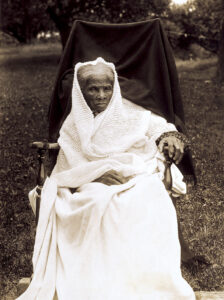
 When we think of things like witness protection or a criminal hiding out, the idea is to find a way to hide in plain sight. A disguise is the first thing that might come to mind, but that is not always the case. When Harriet Tubman, who is best known today as a brave freedom fighter and abolitionist, was in the thick of the movement to free the slaves, she was faced with some particularly dangerous situations. Harriett Tubman was born Araminta “Minty” Ross to enslaved parents, Harriet (“Rit”) Green and Ben Ross in March of 1822. Rit and Ben were enslaved by different families, so it seems unlikely that they would later be able to have a child together, but Mary Pattison Brodess (and later her son Edward), who was Rit’s owner, and Anthony Thompson, who enslaved Ben, would marry, thereby connecting the two families. Thompson ran a large plantation near the Blackwater River in the Madison area of Dorchester County, Maryland. So, Harriett (Minty) was born into slavery. Like most slaves, Tubman was beaten and whipped by enslavers as a child. Those beatings resulted in a traumatic head wound when an irate overseer threw a heavy metal weight, intending to hit another slave, but hit her instead. The injury caused dizziness, pain, and spells of hypersomnia, which occurred throughout her life. The injury resulted in strange visions and vivid dreams, that lasted for the rest of her life. She ascribed to premonitions from God. These experiences, combined with her Methodist upbringing, led her to become devoutly religious.
When we think of things like witness protection or a criminal hiding out, the idea is to find a way to hide in plain sight. A disguise is the first thing that might come to mind, but that is not always the case. When Harriet Tubman, who is best known today as a brave freedom fighter and abolitionist, was in the thick of the movement to free the slaves, she was faced with some particularly dangerous situations. Harriett Tubman was born Araminta “Minty” Ross to enslaved parents, Harriet (“Rit”) Green and Ben Ross in March of 1822. Rit and Ben were enslaved by different families, so it seems unlikely that they would later be able to have a child together, but Mary Pattison Brodess (and later her son Edward), who was Rit’s owner, and Anthony Thompson, who enslaved Ben, would marry, thereby connecting the two families. Thompson ran a large plantation near the Blackwater River in the Madison area of Dorchester County, Maryland. So, Harriett (Minty) was born into slavery. Like most slaves, Tubman was beaten and whipped by enslavers as a child. Those beatings resulted in a traumatic head wound when an irate overseer threw a heavy metal weight, intending to hit another slave, but hit her instead. The injury caused dizziness, pain, and spells of hypersomnia, which occurred throughout her life. The injury resulted in strange visions and vivid dreams, that lasted for the rest of her life. She ascribed to premonitions from God. These experiences, combined with her Methodist upbringing, led her to become devoutly religious.
Tubman became an abolitionist, and started to wage a war on slavery, although she obviously waged war in a very different way than most wars are waged. In 1849, she escaped from her owners and went to Philadelphia, but it was not enough to have her freedom, she wanted her whole family free. So, she returned to Maryland to rescue her family very soon after. It was hard and dangerous work, but she slowly, one group at a time, brought relatives with her out of the state, and eventually guided dozens of other enslaved people to freedom. Tubman, also known as “Moses” traveled by night and in extreme secrecy, but as she later said she “never lost a passenger” on her route. After the Fugitive Slave Act of 1850 was passed, she helped guide escapees farther north into British North America (Canada) and helped newly freed people find work. Tubman met John Brown in 1858 and helped him plan and recruit supporters for his 1859 raid on Harpers Ferry.
Tubman, in order to stay safe, had to hide in plain sight, and as an undercover agent helping escaped enslaved people, she was known to carry chickens with her. You might be wondering why that would be. Tubman had to walk right by slavers, and those sent to recapture escaped slaves, so when she thought a slaver might be getting suspicious of her, she would release the chickens and then recapture them. I’m sure the slavers watched the commotion, but they just thought she was a slave recapturing the chickens for her owners. Little did they know how wrong they were. Simply put, the commotion was so distracting that the slave masters didn’t notice who she was! Sometimes, she would also pretend to read a newspaper, because enslaved people weren’t supposed to be able to read, so she wouldn’t be suspected! While her owners had thought she was just a “dumb slave girl” who didn’t know anything, she was actually a very smart woman, who outsmarted them all.


Harriett Tubman is credited with emancipating about 300 slaves…all while hiding in plain sight!! Pretty wise is you ask me. By 1911, Tubman’s body was so frail that she was admitted into the rest home named in her honor. A New York newspaper described her as “ill and penniless,” which prompted supporters to offer a new round of donations. Just before she died, she quoted the Gospel of John to those in the room, “I go away to prepare a place for you.” Tubman was buried with semi-military honors at Fort Hill Cemetery in Auburn, New York.


Leave a Reply